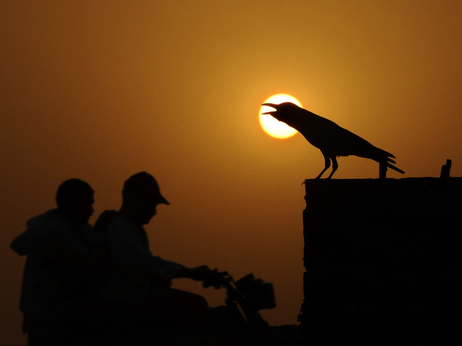Don't underestimate the crow...
No cometas el Error de subestimar al Cuervo...
No cometas el Error de subestimar al Cuervo...
Without a trace of agitation, the male chimpanzee piles up stones in small caches within his enclosure. He does this in the morning, before zoo visitors arrive. Hours later, in an aroused state, the ape hurls the stones at people gathering to watch him.
A detailed report by Mathias Osvath concluded that the ape had planned ahead strategically for the future. It is exactly this feat of mental time travel that psychologist Michael C. Corballis, in his book The Recursive Mind: The Origins of Human Language, Thought, and Civilization, claims is beyond the reach of nonhuman animals. Last week, my review of Corballis's book appeared in the Times Literary Supplement.
Corballis suggests that mental time travel is one of two human ways of thinking that propelled our species into a unique cognitive status. (The other, theory of mind, I won't deal with here.)
During mental time travel, we insert into our present consciousness an experience that we've had in the past or that we imagine for ourselves in the future. Corballis calls this ability mental recursion, and he's right that we humans do it effortlessly. When we daydream at work about last weekend's happy times with family and friends, or anticipate tonight's quiet evening with a book, we engage in mental time travel.
Our highly elaborated ability to insert the past or future recursively into our thinking may play a role in the evolution of human civilization, as Corballis claims. But Corballis's argument is weakened because he dismisses other animals' mental capacities far too readily.
It's not only one chimpanzee in a Swedish zoo who makes me think so.
When our pets grieve, as I wrote about in this space recently, they hold in their mind some memory of the past that causes them to miss a companion.
New research on the pattern of food storage by Eurasian jays indicates that these birds think ahead about what specific foods they will want in the future.
When apes (chimpanzees) and corvids (crows and ravens) make tools to obtain food, they too think ahead to a goal, even as they fashion a tool to solve the problem before them.
In the NATURE documentary film A Murder of Crows, a New Caledonian crow solves a three-part tool-using problem totally new to him (or to any other crow). As one researcher put it, the bird thinks "three chess moves into the future" as he finds one tool that allows him to get another tool that he uses finally to procure food.
Have a look at this crow's stunning problem-solving here. The experimental footage begins at 16:30, but starting at 13:00 offers good context. And the entire film is a delight.
By BARBARA J KING. You can keep up with more of what Barbara is thinking and on Twitter.
Comment: Teresa Howell (SunchokeWoman) wrote:
When my father worked on a ranch, whenever he caught his horses, he gave them a bit of sweet feed. It kept the horses easy to catch. One of his horses, Chip, loved sweet feed, but he was a little lazy.
One morning, as Dad was leading Chip through the gate of the corral to the saddle-rack, he offered Chip another bite of sweet feed. Chip reached for the feed, then shook his head, laid his ears back and refused the feed.
Dad said Chip was mad at himself, because he knew the part his love of sweet feed had in the long day's ride ahead.

No hay comentarios:
Publicar un comentario